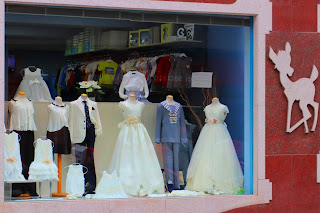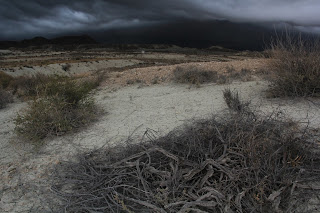I always say that it's a part of my cultural education to get out and about in Spain a bit. Getting out and about has several levels. If you consider that our house is a little island of Britishness then going to a bar and getting a coffee is a journey to Spain. It doesn't really matter whether the out and aboutness is big or small. Memorable things happen on the doorstep just as much as hundreds of kilometres away though, obviously, the reverse is also true!
Out and about can be villages and towns and cities and parks and castles and museums and hills and churches and, even if they fail you, your luck may be better in a restaurant with something that you've never heard of on the menu.
Out and about can be fiestas. Most countries have theatres, cinemas, museums, concerts, coastline, woodland, prehistoric sites and so on and most places have fiestas too. The Tar barl festival in Allendale in Northumberland, the one with the burning tar barrels on the head, is as barmy as anything you'll get in Spain. The big difference seems to be that Spain has these street based fiestas, often with an enormous back story, everywhere and all year round. When Coronavirus becomes just another of those viruses that we live with I'll be trying to persuade Maggie that we should go to see the Cascamorros in Baza and Guadix or the Noche en Vela in Aledo. Who knows we might even get up to Noche de las Animas in Soria or over to Manganeses de la Polvorosa in Zamora now that they've given up on tossing the goat from the church tower. Or maybe that one where they carry people around in coffins, oh, and the one where blokes dressed in rag clothing are pelted with turnips and there are so many with bonfires and demons that I could be kept happy for years. Or maybe just the Moors and Christians in Oliva or Ibi or Petrer will do for now.
One of the problems with digging out places to visit and things to do is that it's not easy to find out about them. Every time we go to Murcia city there seems to be something happening outside the cathedral that I knew nothing about. I wonder why. Much as I dislike it I spend a lot of time grinding through webpage after webpage trying to piece together fragments of information like a second rate Hercule Poirot.
A good example of making an event as difficult as possible are the heats which will decide Spain's entry in this year's Eurovision Song Contest. If I manage to finish this blog today the first semi-final is this evening. Eurovision is quite a big thing here in Spain. It gets a fair bit of publicity because Spain is one of the "Big 5" - the permanent members of Eurovision along with France, Germany, Italy and the United Kingdom which means that the Spanish song gets into the final whatever its quality. Having made the investment the state broadcaster does its best to promote the event. Over the past few years Spain's showing in the competition has been abysmal. This year the TV company decided to make more of the process for choosing the song and to try harder to get decent representation. Entering a song was opened up to almost anyone who wanted to give it a crack. From all those entries an expert panel chose fourteen songs to go on to the next stage. There would be two semi final rounds and then a final to choose the Spanish entry. The rounds and the final would be live with an audience. The town they chose for the concerts was Benidorm.
Now, as Benidorm is only just up the road, I thought we should go and have a look. I don't really care for Eurovision but an event is an event and with this new format I even knew a few of the bands or singers. The spread of styles is pretty impressive. At the last minute one of the acts pulled out because the Eurovision rules don't allow the use of Autotune, and as her song hinged around the robotic voice (a la Cher in Believe), that put paid to her chances. So, from the first moment that Benidorm Fest was mooted I started to look out for tickets. It's a long and tedious story about Covid restrictions and how the tickets were and were not made available. In the end the organisers distributed 500 tickets through a couple of organisations of EuroFans with another bundle handed out on a sort of "old boy" scheme amongst official organisations. No tickets for plebs like us. Maybe we will and maybe we won't watch it on the telly. I'm rooting for Rigoberta Bandini (in the photo), we saw her in Cartagena over the summer but the hot favourite is a song called Terra, a folky type song sung in Galician, by Tanxugueiras.

I think there's another sort of out and aboutness, though Maggie tells me that these are only events in my own distorted imagination. Have you eaten toñas? They look like rounded loaves. Their taste is basically of a sweetened bread. They're pretty typical around here. You'll often get them, served with hot chocolate, at the end of a performance of the local Pinoso group Monte de la Sal. There's a variant to the toña, more usual at Easter time, called a mona. The only difference, as far as I know, is that a mona has a hard boiled egg baked into the crown of the bun. As I did my weekly hunt for events I saw a post from Monóvar town Council reminding people that the toña season was upon us. The post, half denied to me because it was in Valenciano, talked about some tradition of eating monas every Thursday between now and Easter - apparently you need to dance and or sing at the same time. I seem to remember that someone from here in the village told me that in the "olden days," around Pinoso, in the three days after Easter week, people would sally out into the countryside armed with the toñas to do some serious picnicking.
If you're wondering what this has to do with events you have to do a bit of lateral thinking. Because I've not lived here all my life these things are not just a part of my DNA. If these were British we'd be talking Easter egg hunts, addressing the haggis, getting a pint in the beer tent at the village fete or just setting out some laverbread for the visitors. Keeping a tradition alive. It seems to me that turning up in some field in Yecla at some ungodly hour to watch blokes cook gachamigas (those doughy pancakes made with just water, oil, salt and garlic) or walking alongside the romería, taking the Virgin of the Assumption out to Caballusa from Pinoso, complete with free coca in Casas de Pastor (no, different stuff!!) along the way, is much the same. When we lived over in Salamanca we ate hornazo, a sort of chunky meaty pie. The pie got a big boost in sales on the second Monday after Easter. At some time in the past that was the Monday when the Church let the prostitutes back across the River Agueda into the city after their banishment during Lent. The pie was to celebrate.
There's a shop in Benidorm that sells hornazo. That's the Benidorm where we won't be going for the Eurovision heats but where a Vicars and Tarts party might seem absolutely appropriate.












